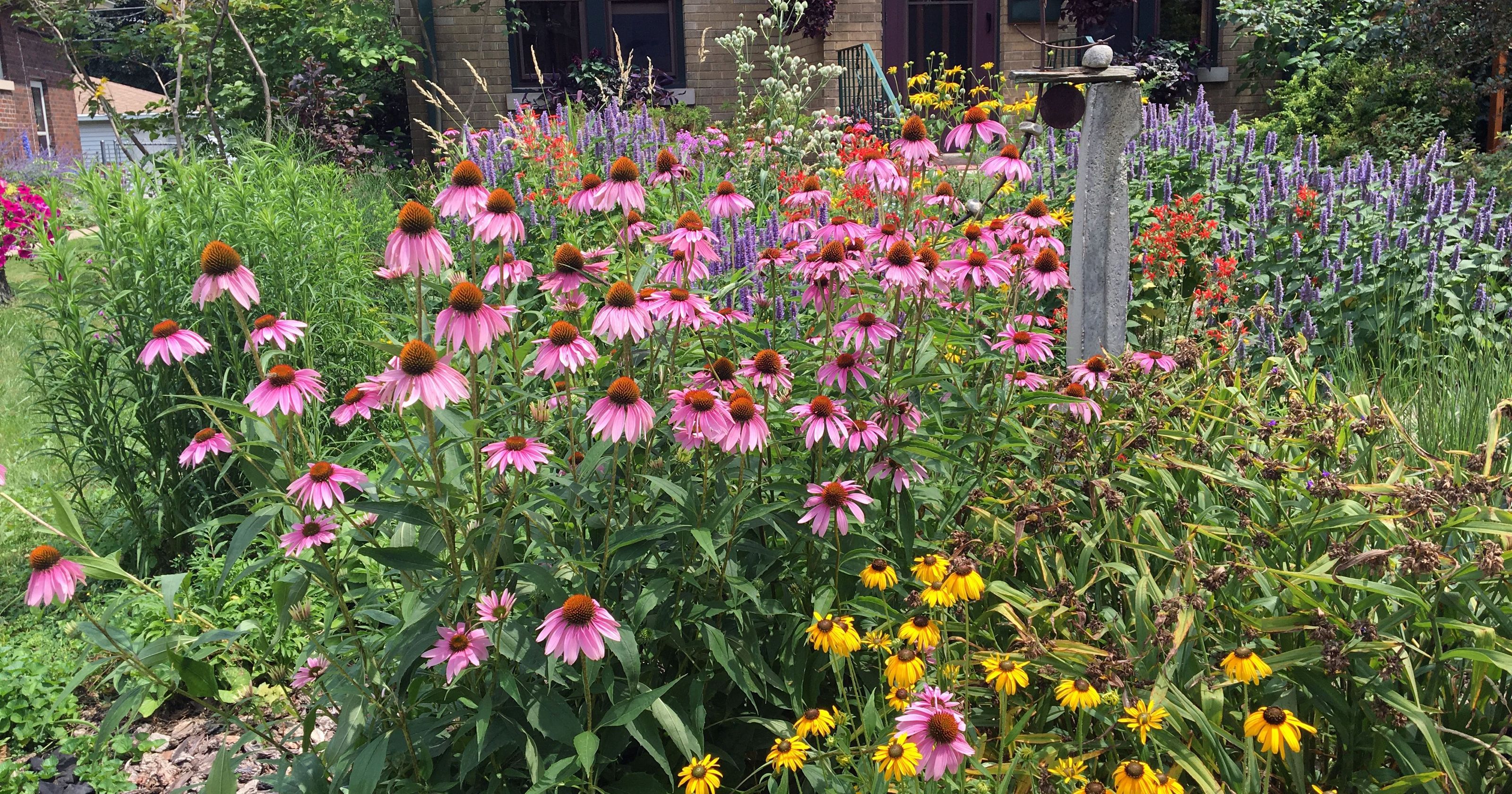April 20, 2019

Planting for Pollinators: A Tale of Two Gardens
by Susan Murray
It’s time to begin purchasing plants for our gardens. Finally, we get to start purchasing those tiny plants, each a promise of what is to come – blooms, beautiful foliage, or good things to eat. My flower gardening is a mixture of careful pre-planning and falling victim to the colorful pictures on the plant markers. As a result, last year I found myself with two distinct garden areas: the native area I had planned and the area where I put the plants that had bewitched me at the nurseries – the non-native annuals.
Both areas grew nicely. I was able to indulge in something that brings me great pleasure - wandering in my garden in the morning, cup of coffee in hand, enjoying the results of my efforts. Then something happened. I realized I was experiencing more joy and satisfaction in the native area than in the non-native area.
While the non-native section was beautiful, it was like a painting – something to be admired for its beauty. The native section was far more complex. Standing there, I was surrounded by life. Tiny bits of life that hummed and buzzed and flitted from bloom to bloom. Hummingbirds darted in and thrust their beaks into their chosen flowers. Bees zoomed around me, pollen making them look like they wore tiny yellow jodhpurs. Hummingbird moths hovered, some so close I could take photos showing their proboscis. Moths and butterflies fluttered from flower to flower, becoming part of the kaleidoscope of color. Every creature was focused on one thing – life. Standing in the middle of my native flower bed with my cup of coffee, I knew that I had made this happen. I was contributing to the survival of these tiny beings because I had chosen to plant native flowers.
Increasing attention is being payed to pollinators, a group that includes bees, butterflies, and moths. Many studies report population declines. Pollinators are essential to maintain the wondrous diversity of life that sustains us. They are a pivotal connection between plants and animals. Why does planting native matter? Simply put, native insects are adapted to native plants.
Your garden and yard provide you with an opportunity to help pollinators. Some things to keep in mind as you choose plants:
by Susan Murray
It’s time to begin purchasing plants for our gardens. Finally, we get to start purchasing those tiny plants, each a promise of what is to come – blooms, beautiful foliage, or good things to eat. My flower gardening is a mixture of careful pre-planning and falling victim to the colorful pictures on the plant markers. As a result, last year I found myself with two distinct garden areas: the native area I had planned and the area where I put the plants that had bewitched me at the nurseries – the non-native annuals.
Both areas grew nicely. I was able to indulge in something that brings me great pleasure - wandering in my garden in the morning, cup of coffee in hand, enjoying the results of my efforts. Then something happened. I realized I was experiencing more joy and satisfaction in the native area than in the non-native area.
While the non-native section was beautiful, it was like a painting – something to be admired for its beauty. The native section was far more complex. Standing there, I was surrounded by life. Tiny bits of life that hummed and buzzed and flitted from bloom to bloom. Hummingbirds darted in and thrust their beaks into their chosen flowers. Bees zoomed around me, pollen making them look like they wore tiny yellow jodhpurs. Hummingbird moths hovered, some so close I could take photos showing their proboscis. Moths and butterflies fluttered from flower to flower, becoming part of the kaleidoscope of color. Every creature was focused on one thing – life. Standing in the middle of my native flower bed with my cup of coffee, I knew that I had made this happen. I was contributing to the survival of these tiny beings because I had chosen to plant native flowers.
Increasing attention is being payed to pollinators, a group that includes bees, butterflies, and moths. Many studies report population declines. Pollinators are essential to maintain the wondrous diversity of life that sustains us. They are a pivotal connection between plants and animals. Why does planting native matter? Simply put, native insects are adapted to native plants.
Your garden and yard provide you with an opportunity to help pollinators. Some things to keep in mind as you choose plants:
- Pollinators need nectar and pollen from early spring to late fall. Choose plants that will bloom in succession.
- In addition to nectar and pollen, insects need a place to lay their eggs, and foliage caterpillars like to eat. Swallowtail caterpillars eat fennel, parsley, and dill. Monarchs, of course, devour milkweed. Learn to love the chewed parts of your plants as evidence you are helping pollinators.
- Choose a variety of colors and forms. Some pollinators prefer daisy-like flowers they can land on. Other prefer flowers with a tubular shape.
- Some trees and shrubs provide support to insects. Good choices include oaks, cherries and basswood.
What you do after planting matters as well. Pesticides kill beneficial insects as well as pests. Bees carry residue to their nest and the young die. If you must use pesticides, use them in liquid form and apply when pollinators are least active
The internet abounds with informative websites. Here are a few:
https://www.ecobeneficial.com/2014/04/planning-pollinator-garden-native-perennials-bees/
http://help.monarchwatch.org/kb/article/38-larval-host-plants-by-butterfly-species
https://arbordayblog.org/treeplanting/want-bees-plant/
https://www.beyondpesticides.org/resources/safety-source-on-pesticide-providers/what-is-integrated-pest-management
The internet abounds with informative websites. Here are a few:
https://www.ecobeneficial.com/2014/04/planning-pollinator-garden-native-perennials-bees/
http://help.monarchwatch.org/kb/article/38-larval-host-plants-by-butterfly-species
https://arbordayblog.org/treeplanting/want-bees-plant/
https://www.beyondpesticides.org/resources/safety-source-on-pesticide-providers/what-is-integrated-pest-management